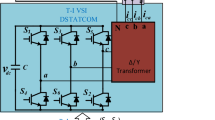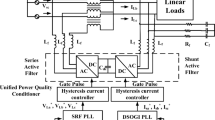Abstract
The power quality (PQ) improvement employing appropriate intelligent controllers is identified as a suitable solution for the dependable, safe, and stable operation in the electric utility systems (EUS). Hence, this paper proposes new types of neural network (NN) based Greedy Least Mean Square (GLMS) controllers for distributed static compensators (DSTATCOM). First, the EUS is developed by considering current source-based non linear load using the MATLAB/Simulink environment. Next, both controllers are implemented by their own learning principle using embedded systems toolboxes. The proposed scheme combines different weighting factors like step size, learning rate and convergence factor to achieve the approximate tuned weight. Then, the final weighting components are achieved by adding DC and AC PI controller weights corresponding to the mean value of active/reactive weight of load currents for the triggering pattern. The proposed control algorithm provides a precise control for the system by maintaining reduced voltage across the self-braced capacitor as compared to the Adaptive Least Mean Square (ALMS) controller. The other PQ merits like better voltage regulation, load balancing, total harmonic distortion (THD) suppression, and power factor (P.F) improvement are attained. Finally, experimental results obtained from the proposed controller fulfill all the shunt-related PQ requirements as per IEEE benchmark for the different case studies.











Similar content being viewed by others
References
Ghosh, A., Ledwich, G.: Power quality enhancement using custom power devices. Springer, New York (2009)
Liu, H., Hussain, F., Shen, Y.: Power quality disturbances classification using compressive sensing and maximum likelihood. IETE Tech. Rev. 35(4), 359–368 (2018)
Thakur, N., Awasthi, Y.K., Siddiqui, A.S.: Reliability analysis and power quality improvement model using enthalpy based grey wolf optimizer. Energy Syst. 12, 31–59 (2021)
Singh, B., Arya, S.R., Jain, C.: Simple peak detection control algorithm of distribution static compensator for power quality improvement. IET Power Electron. 7(7), 1736–1746 (2014)
Singh, B., Jayaprakash, P., Kothari, D.P., Chandra, A., Haddad, K.A.: Comprehensive study of DSTATCOM configurations. IEEE Trans. Industr. Inf. 10(2), 854–870 (2014)
Zia, M.F., Elbouchikhib, E., Benbouzid, M.: Microgrids energy management systems: a critical review on methods, solutions, and prospects. Appl. Energy 222, 1033–1055 (2018)
Liao, H.: Review on distribution network optimization under uncertainty. Energies 12(17), 3369 (2019)
Alizadeh, R., Lund, P.D., Soltanisehat, L.: Outlook on biofuels in future studies: a systematic literature review. Renew. Sustain. Energy Rev. 134, 110326 (2020)
Swarnkar, P., Jain, S.K., Nema, R.K.: Adaptive control schemes for improving the control system dynamics: a review. IETE Tech. Rev. 31(1), 17–33 (2014)
Landau, I.D., Lozano, R., M’Saad, M., Karimi, A.: Adaptive control: algorithms, analysis and applications, 2nd edn. Springer-Verlag, London (2011)
AraujoRibeiro, R.L., De Azevedo, C.C., De Sousa, R.M.: A robust adaptive control strategy of active power filters for power-factor correction, harmonic compensation, and balancing of nonlinear loads. IEEE Trans. Power Electron. 27(2), 718–730 (2012)
Dash, S.K., Ray, P.K.: A New PV-Open-UPQC Configuration for voltage sensitive loads utilizing novel adaptive controllers. IEEE Trans. Industr. Inf. 17(1), 421–429 (2021)
Chilipi, R.R., Sayari, N.A., Beig, A.R., Hosani, K.A.: A multitasking control algorithm for grid-connected inverters in distributed generation applications using adaptive noise cancellation filters. IEEE Trans. Energy Convers. 31(2), 714–727 (2016)
Kabir, M. A., and Mahbub, U.: Synchronous detection and digital control of shunt active power filter in power quality improvement. 2011 IEEE Power Energy Conference at llinois, pp. 1–5, Illinois (2011). https://doi.org/10.1109/PECI.2011.5740499
Mikkili, S., Panda, A.K.: Types-1 and -2 fuzzy logic controllers-based shunt active filter Id-Iq control strategy with different fuzzy membership functions for power quality improvement using RTDS hardware. IET Power Electron. 6(4), 818–833 (2013)
Badoni, M., Singh, A., Singh, B.: Adaptive Neurofuzzy inference system Least-Mean-Square-based control algorithm for DSTATCOM. IEEE Trans. Industr. Inf. 12(2), 483–492 (2016)
Mangaraj, M., Panda, A. K., and Penthia, T.: Neural network control technique based sensor less DSTATCOM for the power conditioning. In: 2015 Annual IEEE India Conference (INDICON), pp. 1–6, New Delhi, (2015). https://doi.org/10.1109/INDICON.2015.7443184
Qasim, M., Khadkikar, V.: Application of artificial neural networks for shunt active power filter control. IEEE Trans. Ind. Inf. 10(3), 1765–1774 (2014)
Arya, S. R., Singh, B., Chandra, A., and AI-Haddad, K.: Control of DSTATCOM using adjustable step least mean square control algorithm. In: 2012 IEEE Fifth Power India Conference, pp. 1–6, (2012). https://doi.org/10.1109/INDICON.2015.7443184
Arya, S.R., Singh, B.: Performance of DSTATCOM using Leaky LMS control algorithm. IEEE J. Emerg. Select. Top. Power Electron. 1(2), 104–113 (2013)
Arya, S., Singh, B.: Neural network based conductance estimation control algorithm for shunt compensator. IEEE Trans. Ind. Inform. 10(1), 569–577 (2014)
Arya, S.R., Singh, B.: Implementation of Kernel incremental metalearning algorithm in distribution static compensator. IEEE Trans. Power Electron. 30(3), 1157–1169 (2015)
Esteban-Sánchez, N., Pizarro, C., Velázquez-Iturbide, J.Á.: Evaluation of a didactic method for the active learning of Greedy algorithms. IEEE Trans. Educ. 57(2), 83–91 (2014)
Mileounis, G., Babadi, B., Kalouptsidis, N., Tarokh, V.: An Adaptive Greedy algorithm with application to nonlinear communications. IEEE Trans. Signal Process. 58(6), 2998–3007 (2010)
Wen, Q., Ma, X.: Efficient Greedy LLL algorithms for lattice decoding. IEEE Trans. Wireless Commun. 15(5), 3560–3572 (2016)
IEEE 519–2014: IEEE recommended practice and requirements for harmonic control in electric power systems (2014)
Patnaik, S.S., Panda, A.K.: Real-time performance analysis and comparison of various control schemes for particle swarm optimization-based shunt active power filters. Int. J. Electr. Power Energy Syst. 52, 185–197 (2013)
Panda, A.K., Mangaraj, M.: DSTATCOM employing hybrid neural network control technique for power quality improvement. IET Power Electron. 10(4), 480–489 (2017)
Mangaraj, M., Panda, A.K.: NBP-based icosϕ control strategy for DSTATCOM. IET Power Electron. 10(12), 1617–1625 (2017)
Oruganti, V.S.R.V., Bubshait, A.S., Dhanikonda, V.S.S.S.S., Simoes, M.G.: Real-time control of hybrid active power filter using conservative power theory in industrial power system. IET Power Electron. 10(2), 196–207 (2017)
Javadi, A., Woodward, L., Al-Haddad, K.: Real-Time implementation of a three-phase THSeAF based on a VSC and a P+R controller to improve the power quality of weak distribution systems. IEEE Trans. Power Electron. 33(3), 2073–2082 (2018)
Mangaraj, M., Panda, A.K.: Modelling and simulation of KHLMS algorithm-based DSTATCOM. IET Power Electron. 12(9), 2304–2311 (2019)
Mangaraj, M.: Operation of Hebbian LMS controlled DSTATCOM. IET Gener. Transm. Distrib. 15, 1939–1948 (2021). https://doi.org/10.1049/gtd2.12146
Author information
Authors and Affiliations
Corresponding author
Additional information
Publisher's Note
Springer Nature remains neutral with regard to jurisdictional claims in published maps and institutional affiliations.
Rights and permissions
About this article
Cite this article
Sabat, J., Mangaraj, M. GLMS control strategy based DSTATCOM for PQ enhancement: modeling and comparative analysis. Energy Syst 14, 495–514 (2023). https://doi.org/10.1007/s12667-021-00489-x
Received:
Accepted:
Published:
Issue Date:
DOI: https://doi.org/10.1007/s12667-021-00489-x




